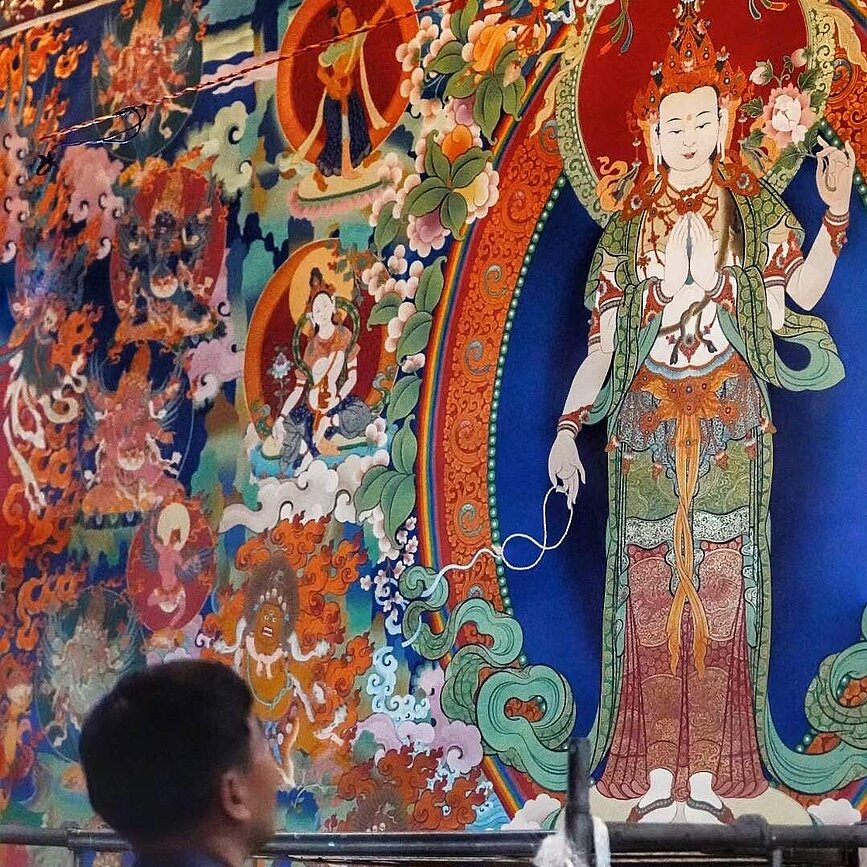Revisiting the "Nanjing Miracle": The Cult and Yogic Practices of the Bodhisattva Avalokiteśvara in Ming China

Topic
In the fifth year of the Yongle Reign in the Ming Dynasty, the Emperor Zhu Di invited the Fifth Karmapa Patriarch bDe bzhin gshegs pa to preside over the Universal Liberation Rite of Water and Land (Pudu Dazhai) at Linggu Temple in Nanjing in order to transfer his deceased parents into the Realm of Super Bliss. The entire ceremony was accompanied by rare auspiciousness and wonders, and it was recorded in a long painted scroll with inscriptions in five languages, thus depicted as the “Nanjing Miracle” by later generations. Undoubtedly, it was a major event in the political and religious history of the early Ming Dynasty. People usually regard this “Universal Liberation Rite” as a political show successfully organized by the Yongle Emperor to establish his political legitimacy. However, there is a lack of basic understanding of its religious form and nature, which leads people to wonder: Why did a “Universal Liberation Rite of Water and Land” for the salvation of ancestors need to specially invite a Tibetan Buddhist master from the distant dBus gtsang to preside over it? A careful examination of Chinese and Tibetan sources related to the life and deeds of the Fifth Karmapa reveals that the wondrously performed Universal Liberation Rite was actually the “Obstacle Removal Ritual of Avalokiteśvara” passed down by the Karmapa sect. The fourteen-day ritual is completely in accordance with the pith instructions of the Obstacle-Removing Ritual of Avalokiteśvara transferred by the Third Karma pa, Patriarch Rang byung rdo rje. This event was not only purposed to save the Ming Taizu couple, but also to save all sentient beings who lost their lives in the wars in the early Ming Dynasty. This may indicate that this “Universal Liberation Rite” was not just a political show, but a religious act with a clear religious purpose. Combining various other documentary materials for a comprehensive investigation, we may think that the Emperor Yongle had very clear Tibetan Buddhist beliefs.
Furthermore, an early Ming collection of 23 Chinese texts on the cult and yogic practices of Bodhisattva Avalokiteśvara of Tibetan tantric Buddhism are found in the Chinese National Library in Beijing. These texts are mostly of Sa skya pa and Karma bKa’‘gyur pa traditions, and translated during the Tangut Xia, Mongol Yuan and Early Ming. The discovery of this text collection reveals the historic fact that the cult and yogic practices of Bodhisattva Avalokiteśvara of the Tibetan Buddhist tradition were widely spread among Tanguts, Mongols and Chinese from early on. By examining these texts on the cult and practices of the Bodhisattva Avalokiteśvara within Tibetan tantric Buddhism, three specific examples of the practice of the Bodhisattva Avalokiteśvara are presented in the collection, those being (1) the deity yoga of Avalokiteśvara; (2) the yogic practice of inner heat (gtum mo) of the deity yoga of Avalokiteśvara; and (3) the yogic practice of luminosity (’od gsal) at the moment of death through the meditative practice of the Bodhisattva Avalokiteśvara. The yogic practices of Bodhisattva Avalokiteśvara can also be classified into two categories, one for self liberation and the other for the salvation of others. The Obstacle Removal Ritual of Avalokiteśvara belongs to the second category. Several texts of this ritual attributed to the Karmapas are seen in this Chinese collection of Early Ming. It testifies that the cult and yogic practices of Avalokiteśvara in Ming China already had a long-standing tradition.
Speaker
SHEN Weirong holds a PhD in Central Asian Science of Language and Culture from Bonn University (1998). He is Professor of Tibetan and Buddhist Philology at Tsinghua University, Beijing, and is the author of Leben und historische Bedeutung des ersten Dalai Lama dGe ’dun grub pa dpal bzang po (1391–1474). Ein Beitrag zur Geschichte der dGe lugs pa-Schule und der Institution der Dalai Lama (Styler Verlag, Institut Monumenta Serica, St. Augustin, Germany, 2002) and Philological Studies of Tibetan History and Buddhism (Shanghai Press of Chinese Classics, 2010). He is currently Numata Visiting Professor of Buddhist Studies at the Department of South Asian, Tibetan and Buddhist Studies of the University of Vienna.
Registration
If you would like to attend the lecture on site, kindly register by 28 June 2024 with an e-mail to office.ikga(at)oeaw.ac.at.
For online participation, please register here: https://oeaw-ac-at.zoom.us/meeting/register/u5ItceGtpz8pHNcQs8mVitAv5S6VWuTnDvHt.
Numata Chair Lectures at the IKGA
The Numata Chair in Buddhist Studies at the University of Vienna was established in 1999 as an endowed chair for visiting professors. Lectures at the Austrian Academy of Sciences by Numata Chair holders were introduced in 2019.
The Numata foundation (Bukkyō Dendō Kyōkai) is named after Dr. Yehan Numata (1897–1994), chairman of the Mitutoyo Manufacturing Company. A devout Buddhist, Dr. Numata believed that the dissemination of Buddhist teachings would be beneficial to humanity and pursued the promotion of Buddhism internationally. The foundation supports academic programmes in Buddhist Studies worldwide and has endowed several professorships at leading research universities.